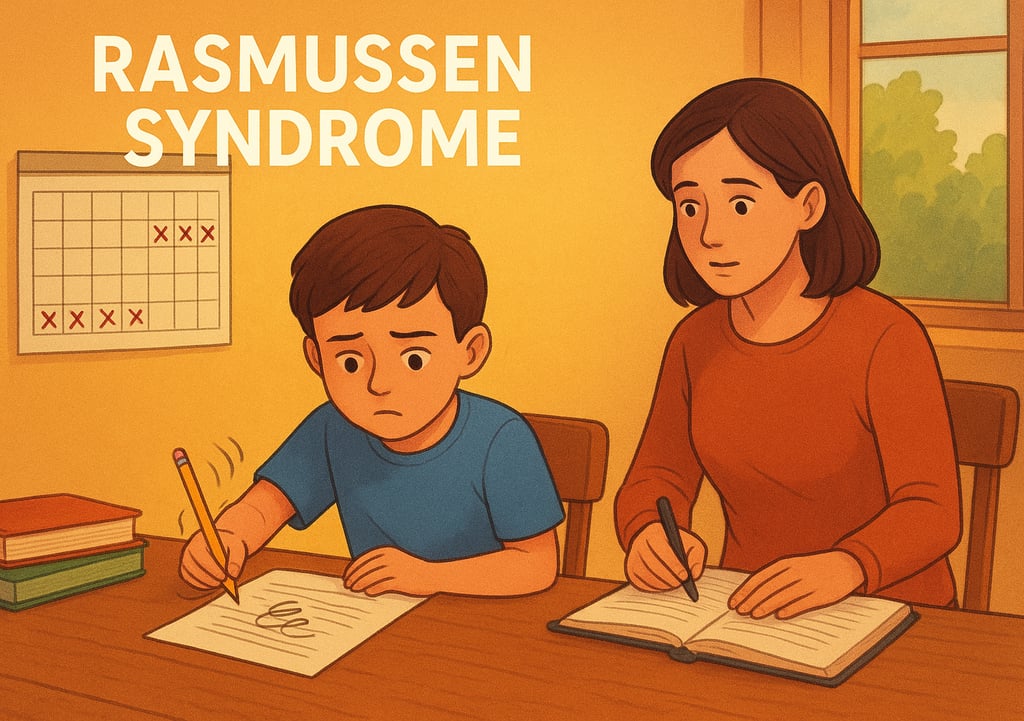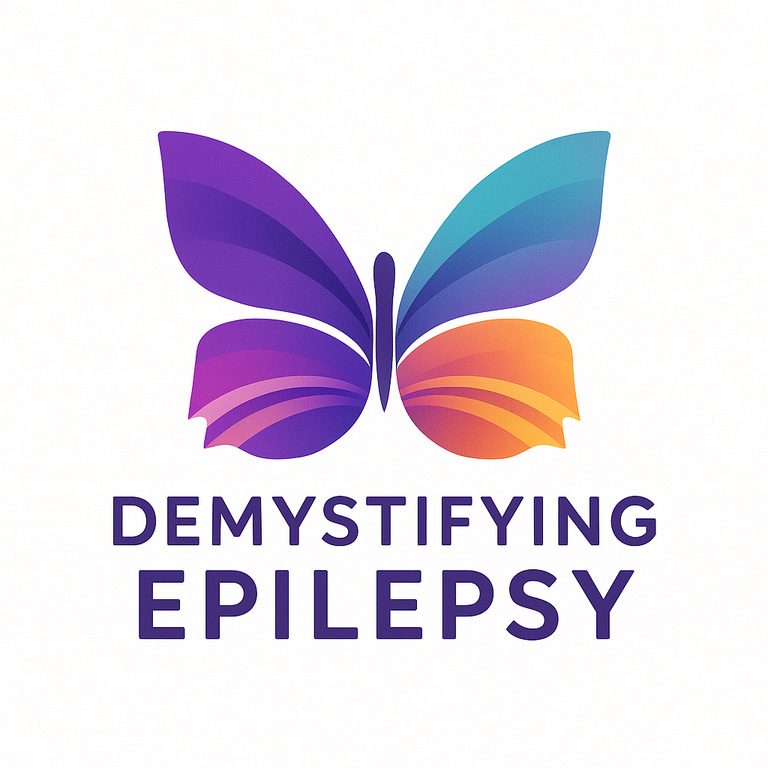Understanding Rasmussen Syndrome (RS) - Meet Jorge
When a child is suddenly seized by frequent, unrelenting focal seizures and then begins to lose strength or language skill on one side of the body, the diagnosis may turn out to be Rasmussen Syndrome (RS). It’s rare, it’s serious, and it demands urgent understanding and action. This blog post seeks to explain RS clearly: what it is, how it presents, how it is treated and managed, and how families live with it. To bring this into sharp, relatable focus, we’ll follow the journey of Jorge, a fictitious but realistic child whose story reflects many features of RS.
Dr. Clotilda Chinyanya
11/21/20256 min read


What is Rasmussen Syndrome?
Rasmussen Syndrome, also called Rasmussen encephalitis, is a rare neurological disorder characterized by:
Persistent, focal seizures (especially focal motor seizures) that are difficult or impossible to control with standard anti-seizure medications.
Progressive deterioration of one hemisphere (one side) of the brain, seen on imaging as hemispheric atrophy, and clinically as weakness (hemiparesis), vision deficits (hemianopia), and language declines (if the dominant hemisphere is involved).
An apparently autoimmune or inflammatory process affecting one cerebral hemisphere.
In more detail:
Onset typically occurs between ages 1–10 (median around age 6) though about 10% of cases begin in adolescence or adulthood.
The disease evolves in three stages:
Prodromal phase: Mild seizures, maybe mild weakness on one side.
Acute phase: Frequent seizures, increasing neurological deterioration.
Chronic/residual phase: Permanent impairments, ongoing epilepsy, stable but significant disability.
The exact trigger is unknown, but some studies point to perinatal complications, or antecedent brain lesions or autoimmune facial conditions as possible predispositions.
Because RS is rare and complex, diagnosis and management require expert teams. But understanding it early can make a difference.
Jorge’s Story: A Family’s Path Through RS
Let’s imagine Jorge, a bright and active 5-year-old boy, living with his parents and younger sister in a suburban home. He enjoyed soccer, building Lego castles, and running around the backyard.
Stage 1 – The First Signs
One evening, while practicing his soccer kicks, Jorge suddenly froze with his right arm raised and remained stiff for a few seconds. His mother thought maybe he was just daydreaming. Over the next month, small events recurred: a twitch of his right-hand during play, a short shrug of the right shoulder while eating. His pediatrician attributed it initially to “benign focal seizures” and started an anti-seizure medication.
Stage 2 – Escalation
Within weeks, the seizures increased in frequency and became more dramatic: repeated clonic jerks of his right arm and face (focal motor seizures), sometimes evolving into more sustained episodes. The neurologist ordered an MRI, which showed subtle enlargement of sulci and signs of inflammation on the left hemisphere (remember: The right side of the brain controls the left side of the body and vice-versa). An EEG revealed continuous focal discharges in the left hemisphere. At the same time, his kindergarten teacher noticed Jorge’s right-hand writing was slower, his speech slightly slurred when tired. His neurologist explained: “I’m worried about a rare condition called Rasmussen Syndrome.” The diagnosis was devastating. In RS, seizures are frequently drug-resistant and the brain damage may progress. There was a good deal of uncertainty and urgency.
Stage 3 – Navigating Treatment and Life
Jorge’s family met a pediatric epileptologist, a neuroimmunologist and a neurosurgeon. They began immunomodulatory therapy (high-dose steroids and IV immunoglobulin) in hopes of slowing inflammation. At the same time, his seizures persisted, and new weakness on his right side (hemiparesis) began to show. His MRI follow-up after 3 months revealed increasing atrophy of the left hemisphere. The team discussed hemispherectomy (disconnecting the affected hemisphere) to stop seizures and preserve function in the unaffected side.
The decision was heart-wrenching. Surgery would result in permanent hemiparesis on the right side and visual field loss, but it offered the best chance at seizure control and preserving cognition. After many meetings, the family opted for the procedure. Post-surgery, Jorge had no further full-blown seizures, though he needed intensive rehabilitation that include physical therapy, speech therapy, occupational therapy, and adaptation to his new realities (learning to use his left hand more, coping with visual field loss). He returned to school in a special program, with accommodations.
Stage 4 – Life After Surgery
Today, at age 8, Jorge remains seizure-free for nearly 2 years. He still uses his left hand more, and his gait (manner of walking) is modestly changed, but he attends regular school with help, plays catch with his dad, and draws his favorite scenes. The family remains vigil-ant: they keep a seizure diary, monitor for any signs of leftover activity, and continue periodic neuro‐medicine follow-ups.
Jorge’s story illustrates key truths of RS, the early subtle signs, the rapid escalation, the need for aggressive multidisciplinary treatment, and the way a family adapts and perseveres.
Key Clinical Features and How They Show Up
Here’s a summary of how RS typically presents and how you might recognize it:
Seizures: Focal (usually motor) seizures, often involving one arm/leg/face; sometimes evolving to epilepsia partialis continua (continuous focal jerks).
Progressive neurological signs: Over time, one side of the body (contralateral to the affected hemisphere) becomes weaker; vision on one side declines; speech or language may decline if the dominant side is involved.
Imaging findings: MRI shows progressive hemispheric atrophy, abnormal signal/inflammation in early phase.
EEG findings: Focal slowing, focal discharges, often evolving as damage increases.
Phases: Prodromal → acute → chronic.
Etiology: Most likely immune/inflammatory; Tcell infiltration and microglial activation found in affected brain tissue.
Treatment resistance: Standard anti-seizure medications often fail. Surgery is often the only way to gain meaningful control.
Diagnosis: What to Do and Ask
If RS is suspected, these are some important steps and questions for families:
Get a detailed history: age of onset, seizure types, frequency, evolution of neurological deficits.
Ensure MRI and EEG are done (and repeated). Ask about signs of hemispheric atrophy or progressive change.
Ask about immunologic/immunotherapy work-up: sometimes CSF (cerebro-spinal fluid) shows oligoclonal bands; workup for autoimmune/viral triggers may be done.
Consult a team: neurologist/epileptologist, neuroimmunologist, neurosurgeon, rehabilitation therapy. Early team coordination improves outcome.
Discuss surgical options early: In RS, hemispherectomy (or anatomical hemispherectomy) is often the most effective way to control seizures and halt further brain damage.
Ask about the non-seizure impacts: how will motor, language, cognition outcomes evolve? What supports will be available (therapy, school accommodations, rehab)?
Discuss timing: earlier surgery often yields better results because prolonged seizures and inflammation cause irreversible damage.
Treatment and Management
Anti-Seizure Medications & Immunotherapy
While standard anti-seizure medications are used, their success in RS is limited due to the underlying inflammatory process. Immunomodulatory therapies (e.g., high-dose steroids, IVIG, plasmapheresis, immune-suppressants) may slow progression in the acute phase.
However, these treatments alone rarely reverse damage; they aim to reduce inflammation and preserve remaining function.
Surgical Intervention
One of the hallmarks of RS management is surgery, often functional hemispherectomy (disconnecting the affected hemisphere from the rest of the brain). The goal is to:
Stop seizures (or greatly reduce them)
Prevent further damage from ongoing seizures and inflammation
Allow the unaffected hemisphere to take over more function (especially in young children with neural plasticity)
Studies show earlier surgical intervention leads to better outcomes in seizure freedom and preservation of cognition/motor skills.
Rehabilitation, Therapies, Long-Term Support
Post-surgery and ongoing care involves:
Physical therapy: to manage hemiparesis and strengthen remaining function
Occupational therapy: to assist daily living skills, adapt to any hand or limb loss
Speech/language therapy: especially when language area was involved
School support/IEP (Individualized Education Plan): children may need special accommodations, assistive technology, vision support (if hemianopia)
Psychosocial support: for child and family to cope with the diagnosis, surgical outcomes, and adaptation
Monitoring and Quality of Life
Patients require long-term follow-up: monitoring for seizure recurrence, cognitive progression, motor development, and quality of life. Families should keep seizure diaries, schedule periodic imaging/EEGs, and work with their medical team around therapy goals.
Prognosis: What to Expect
Because every case is different, prognosis in RS is variable. Key points:
If left untreated or if surgery is delayed, ongoing seizures and inflammation cause irreversible damage and worse outcomes: motor deficits, cognitive decline, persistent epilepsy.
If surgery is performed early, chances of seizure control improve and remaining hemisphere may compensate well.
Motor, vision, language outcomes depend on which hemisphere is affected, the age at intervention, and how much function transfers.
Even with surgery, some disabilities (hemiparesis, vision field defects, speech delay) may remain. The goal is not always “normal” but “best possible life.”
Adults or late‐onset cases may have slower progression and somewhat better outcomes with immunotherapy.
Practical Guidance for Families
Here are some practical steps families of a child with RS (or suspected RS) can take:
Keep clear documentation: seizure logs (type, duration, frequency), therapy progress, imaging/EEG reports.
Build your care team: neurologist, neurosurgeon, rehabilitation specialists, school support personnel.
Assess home and school environment: safety, seizure action plan, adaptation for mobility/vision/language changes.
Engage early in discussions about surgery, immunotherapy and rehabilitation. Ask questions:
What are the risks and benefits of hemispherectomy in my child’s specific situation?
How soon should surgery be done?
What rehabilitation plan will follow?
Advocate for your child’s education: support services, assistive devices, speech/OT/PT.
Take care of your family’s emotional and logistical well-being: siblings, parental stress, long-term planning.
Connect with support groups or other families living with similar diagnoses. Shared experience helps.
Wrapping Up: Hope, Adaptation, and Perspective
When I first meet the families of children like Jorge, I often hear the question: “Will things ever be ‘normal’ again?” The truth is, RS changes the trajectory, but it does not eliminate possibility. With early and aggressive intervention, good rehabilitation support, and a strong family and medical team, many children go on to lead meaningful, active lives—though it may look different than what was originally envisioned.
For Jorge, the early surgery meant a visible limp and right-hand changes, but it also meant no more full-blown seizures, and preserved cognition to return to school and play. His family adapted, therapists met him where he was, and his narrative shifted from “What will we lose?” to “What can we build?”
If you are walking the RS journey, your path will be uniquely your own—but you are not alone. Ask questions, demand early intervention, surround yourselves with support, and celebrate the small wins (a seizure-free week, a new ability, a brighter smile). Because for a child with RS, every step forward is meaningful.
Further Reading:
Choose Knowledge:
